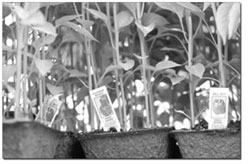| ||
My seedless spring
by Ari LeVaux The pioneer archetype looms large in the collective unconscious of Western mythology. Strong, independent, resourceful and largely fictional, this heroic frontiersman can bake bread over a campfire in the blowing snow, deliver a calf at midnight, mend fence all day and then ride home into the sunset. Yet while one pioneer tended the herd, you can bet another was tending the garden, making applesauce, shelling peas and raising hens – all just as gritty and heroic as bouncing around on some horse. Indeed, the garden is every inch the natural battleground as a forest or a cattle range. You’re out there, exposed to the elements, growing enough food to survive the winter. In my personal, romanticized version of this myth, vertical integration is key. Building your house is good; if you also felled the trees, peeled the logs, etc., that’s even better. In this spirit, I’ve always made a point to grow my garden from seed. My wintertime seed-ordering ritual involves getting cozy with a cup of tea and a stack of catalogs – Fedco and Johnny’s are my favorites. I read the descriptions of the various plants, plan my garden and dream of summer – dreams grounded in the reality that each passing day brings us closer. By ordering seeds, I’m investing in that reality. And when it comes to raising seedlings, it’s not enough just to be pretty good – even a B+ amounts to a failing grade. Cultivating starts is like curling – that north country sport in which players vigorously sweep the ice in front of an enormous piece of gliding granite. If the rock loses momentum, no amount of sweeping will get it going again. So, too, in the greenhouse, where any number of factors can cause the little plants to get stressed, which will set them back days, weeks, months or forever. Too wet, too dry, too hot, too cold, too bright, too dim – any of these circumstances can hurt plants, and once they lose their momentum, it’s nearly impossible to catch up. A plant, a tomato, say, that’s behind the ball when put in the ground, or is planted late, might be too small to bear much fruit when summer hits. Maybe you’ll get a few tomatoes, but not what you need to survive the winter. A well-developed plant, meanwhile, will hit the ground running. Clearly, if you want a fantastic August, you need a perfect March. And if you don’t have a perfect March, you’re better off buying starts from someone who did. Just as careless sex can lead to a lasting commitment in the form of a child, a carefree romp in the seed catalogs can saddle you with many little green life forms to care for. Last year was typical for me. My seedlings lived like orphans bouncing around foster homes. They started in the basement under grow lights, were moved in front of a big window when the days were long enough, and once in a while the trays spent an afternoon outside for some fresh air. Finally they went to the greenhouse, where cold nights, hot days and erratic watering put the starts in survival mode. They survived but they did not thrive – a condition exacerbated last year by surprisingly lame store-bought potting soil, Glacier Gold brand. But it’s a poor workman who blames his tools. A real pioneer, of course, or a real farmer, would have made his own potting soil. Every spring when the farmers’ market opens, I come face-to-face with starts raised in stable homes by growers who really know what they are doing. It’s humiliating, and it’s grounding. On paper, it makes questionable financial sense to buy starts at the market, where one plant might cost more than a whole packet of seeds. I’ve fallen prey to this logic for years. I’ve even clung to this failed logic to the point where I’ve actually put my sorry plants in the ground anyway, which effectively dooms my garden for the year. So this year, I’m going to restrain my pioneering impulses and buy my starts from the experts. Instead of wasting time and money on a romantic exercise in futility, I’m going to make my garden into the best home possible for the starts I bring home from the market. In plugging into my local economy this way, I’m embracing my community, with warm and fuzzy paybacks like the special relationship that can develop between the gardener and the greenhouse whiz. Imagine knowing that all across town, people have planted the starts you raised. It’s like they’re raising your children. “You get updates all summer long,” says one farmer friend. “They’ll say things like, ‘That Sungold tomato plant you sold us, oh my god, they taste like candy!’” So, while being a go-it-alone pioneer is a cool concept, being a player in a vital community is even cooler. This year, with all of the extra garden time I’ll have on my hands, I’m going to focus on irrigation. Rather than studying the Fedco or Johnny’s seed catalogs, I’ll be thumbing through the Peaceful Valley Farm Supply catalog, scheming about the drip irrigation system I’m installing this spring. I want it to be water-wise, easy to manage, and ready to go when I bring home my adopted starts. •
|
In this week's issue...
- January 25, 2024
- Bagging it
State plastic bag ban is in full effect, but enforcement varies
- January 26, 2024
- Paper chase
The Sneer is back – and no we’re not talking about Billy Idol’s comeback tour.
- January 11, 2024
- High and dry
New state climate report projects continued warming, declining streamflows


